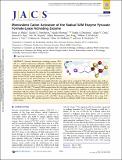Monovalent Cation Activation of the Radical SAM Enzyme Pyruvate Formate-Lyase Activating Enzyme
Author(s)
Shisler, Krista A.; Hutcheson, Rachel U.; Horitani, Masaki; Duschene, Kaitlin S.; Crain, Adam V.; Byer, Amanda S.; Shepard, Eric M.; Rasmussen, Ashley; Yang, Jian; Broderick, William E.; Hoffman, Brian M.; Broderick, Joan B.; Vey, Jessica Lynn; Drennan, Catherine L.; ... Show more Show less
Downloadjacs.7b04883.pdf (5.752Mb)
PUBLISHER_POLICY
Publisher Policy
Article is made available in accordance with the publisher's policy and may be subject to US copyright law. Please refer to the publisher's site for terms of use.
Terms of use
Metadata
Show full item recordAbstract
Pyruvate formate-lyase activating enzyme (PFL-AE) is a radical S-adenosyl-l-methionine (SAM) enzyme that installs a catalytically essential glycyl radical on pyruvate formate-lyase. We show that PFL-AE binds a catalytically essential monovalent cation at its active site, yet another parallel with B₁₂ enzymes, and we characterize this cation site by a combination of structural, biochemical, and spectroscopic approaches. Refinement of the PFL-AE crystal structure reveals Na + as the most likely ion present in the solved structures, and pulsed electron nuclear double resonance (ENDOR) demonstrates that the same cation site is occupied by ²³Na in the solution state of the as-isolated enzyme. A SAM carboxylate-oxygen is an M⁺ ligand, and EPR and circular dichroism spectroscopies reveal that both the site occupancy and the identity of the cation perturb the electronic properties of the SAM-chelated iron-sulfur cluster. ENDOR studies of the PFL-AE/[¹³C-methyl]-SAM complex show that the target sulfonium positioning varies with the cation, while the observation of an isotropic hyperfine coupling to the cation by ENDOR measurements establishes its intimate, SAM-mediated interaction with the cluster. This monovalent cation site controls enzyme activity: (i) PFL-AE in the absence of any simple monovalent cations has little-no activity; and (ii) among monocations, going down Group 1 of the periodic table from Li⁺ to Cs⁺ , PFL-AE activity sharply maximizes at K⁺ , with NH₄⁺ closely matching the efficacy of K⁺. PFL-AE is thus a type I M⁺-activated enzyme whose M⁺ controls reactivity by interactions with the cosubstrate, SAM, which is bound to the catalytic iron-sulfur cluster.
Date issued
2017-08Department
Massachusetts Institute of Technology. Department of Biology; Massachusetts Institute of Technology. Department of ChemistryJournal
Journal of the American Chemical Society
Publisher
American Chemical Society (ACS)
Citation
Shisler, Krista A. et al. “Monovalent Cation Activation of the Radical SAM Enzyme Pyruvate Formate-Lyase Activating Enzyme.” Journal of the American Chemical Society 139, 34 (August 22, 2017): 11803–11813 © 2017 American Chemical Society
Version: Final published version
ISSN
0002-7863
1520-5126